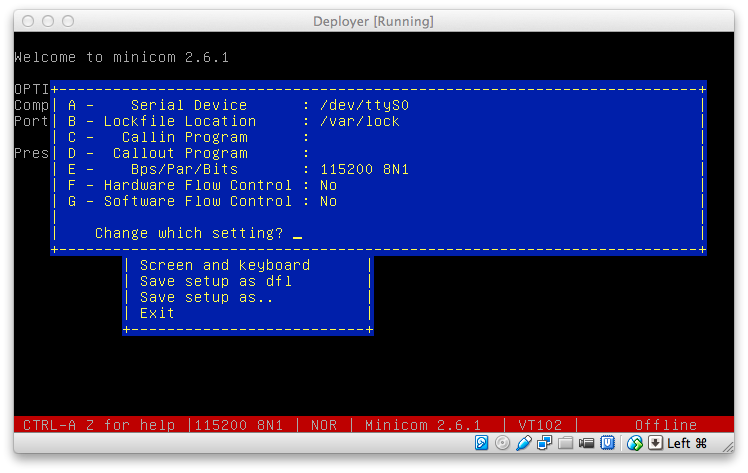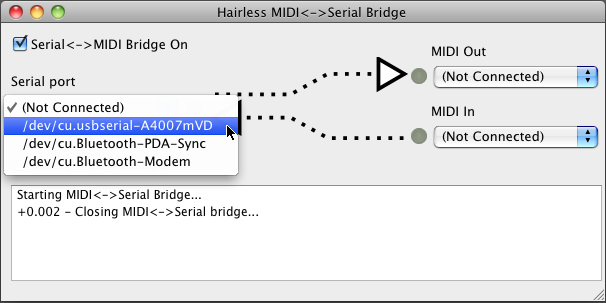Mac Os X List Serial Devices
Is there an OS X terminal program that can access serial. Can use it to work with Linux or other devices that. Serial terminal for Mac OS X is.


Agito:~ jeroen$ ioreg -p IOUSB +-o Root +-o Root Hub Simulation Simulation@14000000 +-o BRCM20702 Hub@14300000 +-o Bluetooth USB Host Controller@14330000 +-o IOUSBHostDevice@14100000 +-o HP LaserJet Professional P1102w@14120000 +-o IOUSBHostDevice@14140000 +-o Keyboard Hub@14110000 +-o Apple Keyboard@14112000 +-o Mad Catz R.A.T.3 Mouse@14111000 +-o IOUSBHostDevice@14500000 +-o IOUSBHostDevice@14540000 +-o USB2.0-Serial@14200000`` Since the introduction of micro-USB, some USB cables are not fully wired. You might have a charge-only cable. In that case the device will never work.
For OS X 10.9+ • /Library/Extensions/osx-ch341.kext • /Library/Extensions/osx-pl2303.kext For OS X 10.8 and earlier • /System/Library/Extensions/osx-ch341.kext • /System/Library/Extensions/osx-pl2303.kext When no conflicting drivers are installed, the output on OS X 10.9+ should look like: In case you have found conflicting drivers, like the ProlificUsbSerial.kext (Prolific) or usb.kext (Winchiphead), you should remove them. Execute the following steps in the terminal: • cd // • sudo kextunload./.kext • sudo rm -rf.kext The kextunload command may fail if the driver is not loaded. It may be necessary to reboot the mac to be sure the kexts are not loaded into the kernel. Test If the Driver is Loaded Next step is to check if the driver is loaded.
Connect your USB to serial cable to your mac and execute the following command in Terminal: sudo kextstat grep repleo If you don’t see a driver, please make sure it is loaded by using the commands: • cd /library/extensions/ • sudo kextutil -v 6./.kext Alternatively, rebooting your mac will also load the drivers. Charpentier Prelude From Te Deum Pdf Printer. If you don’t see the driver, it is possible you don’t own a supported device, or the driver is not loaded properly. Try to load the driver with the verbose command: sudo kextutil -v 6./.kext in the directory /library/extensions, inspect the output of sudo dmesg and contact us via for further assistance. Since OS X High Sierra, you need to approve the driver.
You will get a dialog System Extension Blocked during installation, which alerts you to approve the driver in System Preferences >Security & Privacy. In case the kextutil command shows the line. Test the Serial Interface with a Loopback The last test is to verify the driver is really able to send and/or receive data. Connect the RxD and TxD pin of the RS-233 connector, this will create a loopback. Any character transmitted from your Mac should also be echoed into the terminal. Use a simple tool like to verify if data is transmitted. In case no data is received, it is important that is not a hardware failure.
Please test the setup using Windows or Linux to ensure the hardware is operating correctly. If the hardware is not the problem, you can contact for assistance. Please include all the steps you did to determine the cause of the problem.
Requirements You have assembled your or your, installed the appropriate drivers, and flashed the OS image (formerly called firmware). Steps to Set Up a Serial Terminal • Launch Spotlight by pressing Cmd + Space. • Type terminal. • Select the Terminal app.
• In the Terminal window, enter the command: ls /dev/cu.usbserial-* • In the list of connected devices, look for a device that contains cu. The Peacemaker Ken Sande Ebook Download. usbserial. In the example above, the device name is /dev/cu.usbserial-A402YSYU. Note: If your device is not in the list, verify that your board is powered on and connected to your system. Select the appropriate link below: • • • Connect to the USB serial device using the Terminal screen utility by entering the command: screen /dev/xx.usbserial-XXXXXXXX 115200 –L where /dev/xx.usbserial-XXXXXXXX is replaced by your device unique name. Using the example above, the command would be: screen -L /dev/cu.usbserial-A402YSYU 115200 –L Note: Adding –L to the command, as shown above, turns on output logging so you can see the results of your commands. To end a session in Screen type Ctrl + A and then Ctrl + K to kill the session.
You will be prompted to end the session. • At the blank screen, press Enter twice. A login screen is displayed. • At the login prompt, type root and press Enter. • Press Enter when prompted for a password.
The following screen is displayed: You have now established a serial communication with your board. You can interact with your board by entering common Linux commands. For a summary of useful commands, see.